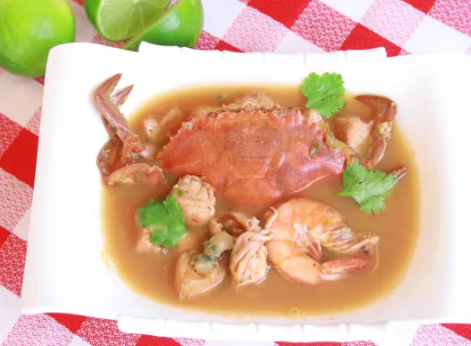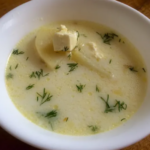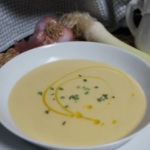Venezuelan phosphorus soup is a typical dish from the coastal area of eastern Venezuela. Aphrodisiac qualities are attributed to this recipe due to the wide variety of maritime ingredients it contains. The Venezuelan shellfish matchstick provides a high nutritional content, which is why it is said in Venezuela that it “raises even a dead person”. Its preparation is laborious but simple, and the reward is worth it.
Ingredients to make Venezuelan Fosforera:
- Base stew (soup):
- 1 fish head (optional)
- 3 liters of water
- ½ medium onion
- ½ head of garlic
- ½ paprika
- 2 sweet peppers
- ½ sprig of leek
- 4 ripe tomatoes
- 1 pinch of sliño (to taste)
- 1 pinch of salt and pepper (to taste)
- 1 sprig of coriander
- Seafood:
- 1 kilogram of shrimp
- 1 kilogram of squid
- ½ kilogram of scallops (optional)
- ½ kilogram chipi
- ½ kilogram of crabs
- ½ kilogram of clams (optional)
- 1 sprig of coriander

How to make Venezuelan Fosforera:
- Cut all the vegetables (without taking much care of their appearance) into thick squares, except the cilantro and the tomatoes. As for the coriander, cut one part finely and the other coarsely (one part will be for the stew and the other for the end of the preparation). Booking.
- Trick: Buy ripe tomato for this preparation.
- In the case of tomato, remove the seeds and the skin, discard both. Chop or grate the tomato and reserve.
- Clean the shellfish under the tap, without going overboard with the water. First remove the shells and heads of the shrimp but do not discard them, reserve both. Next step, remove the intestine of the shrimp, which is a black vein that runs through its body. Booking. It is important to wash the shellfish but the excess of fresh water is not highly recommended for these sea products, only what is necessary for them to be clean.
- Trick: In many restaurants they leave the intestine of the shrimp, because it is not toxic.
- Next step, clean the squid. The body of the squid is divided into head and body. On the head are the tentacles and the beak. While in the body, below and outside the fins are located, inside the viscera and the spine (cartilage). Hold your head with one hand and your body with the other. Pull the head, until all the interior (viscera and cartilage) is extracted. Once the body is separated from the head, reserve the body and place the head on a cutting board.
- Trick: Inside the viscera of the squid there is a small bag of ink that, following certain indications, can be used for certain dishes. However, if handled poorly, it is toxic.
- There you make a cut above the eyes of the squid, on the side of the viscera and discard the last ones. Continue with the head, separate the tentacles and you will find the mouth of the squid. Push from below, with the other hand, pull out the beak (like a beak) and discard. Wash the head under the tap, take the opportunity to slide your fingers through each tentacle and remove something similar to rings of cartilage. Go ahead, remove and discard the eyes, clean the head with water to remove any traces of ink. Reserve the head.
- Now hold the body and remove the fins. When detaching the fins, a skin is coming, remove it too. Finish removing the skin from the body and if you can, the second skin, so you avoid it feeling like gum at the end of the preparation (the Japanese make it that way). Turn the squid over, as if it were a stocking, and if you find traces of gallbladder or cartilage, remove them. Wash under the tap lightly, inside and out. Finally, chop the body into rings, the head into 2 parts (including tentacles). Booking. As for the fins, remove the skin, wash, cut into 3 parts and reserve.
- Tip: For very large squid, you must previously submerge them in water with 1/4 teaspoon of baking soda.
- In the case of chipis (also scallops, if you prefer), wash them twice until most of the sand is removed and set aside. Chipi are more delicate and soft than scallops, so you should avoid over washing them. In contrast, scallops require more detailed cleaning.
- Pour water into a large saucepan and wait until it boils. Then add the fish. Submerge the dogfish for a few seconds in the boiling water, remove and reserve.
- Scrape the skin of the dogfish with a knife, until it is removed. Later, rub a lemon on the dogfish to eliminate the smell of ammonia. Rinse lightly, under the tap.
- Use a large saucepan, pour water and wait for it to boil. At that time, add the fish head, the shells and shrimp heads, the onion, the garlic, the paprika, the sweet pepper, the leek and the tomatoes. Cook the seafood broth for 40 minutes.
- Tip: Add more water if the liquid is consumed too much.
- Strain the seafood broth you prepared, reserving the liquid obtained and discarding the solids.
- In the same pan, add all the shellfish (shrimp, squid, crabs, chipi chipi, scallops and clams) season and add salt and pepper to taste. Cook for 10 minutes. Two minutes before the end of cooking, add the reserved cilantro.
- Tip: Remember that the scallops and clams are optional.
- Ready to serve! Place some lemons cut in half on the table, so each diner will add a citrus touch to their Venezuelan phosphorus soup if they feel like it. This dish is ideal for a weekend, a special night or a family share. Fancy this exotic Caribbean delicacy? If you are enthusiastic about the idea and you concrete it, please share with us your gastronomic experience.



